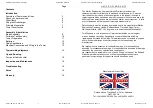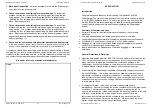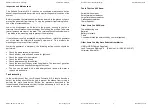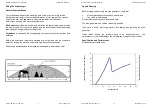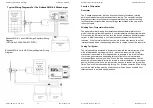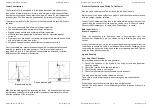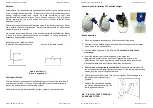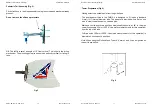
Rutland Furlmatic 910-4 Windcharger Installation & Operation
Doc No: SM-138 Iss. A 29.01.13
18
Marlec Eng Co Ltd
5.
Mechanical inspection.
It may be necessary to remove the Windcharger
from its pole for the following tests.
6.
Check the brushes and slipring for wear or damage.
To inspect the
brushes, remove the cover from the main housing by removing the four
fixing screws. The brushes and slipring can be then be inspected by
removing the four self-tapping screws holding the brush holder assembly in
place. Remove any black
7.
Check the brushes and slipring for wear or damage.
To inspect the
brushes, remove the cover from the main housing by removing the four
fixing screws. The brushes and slipring can be then be inspected by
removing the four self-tapping screws holding the brush holder assembly in
place. Remove any black deposits from slipring with emery paper. Heavy
deposits and reduced power indicate a possible reverse connection to the
battery (see Page 11).
8.
Check hub for free rotation with generator disconnected from battery.
If the hub does not rotate freely, check for a possible short circuit in the
wiring. If no wiring fault is found refer to your dealer or manufacturer.
If the above checks have identified a need for spare parts or failed to identify
the problem you should contact Marlec who can advise you of your nearest
distributor in their world wide network. In the first instance we recommend that
you contact the company from whom the product was originally purchased.
If in doubt, refer to your dealer or manufacturer.
Notes
Rutland Furlmatic 910-4 Windcharger Installation & Operation
Doc No: SM-138 Iss. A 29.01.13
3
Marlec Eng Co Ltd
INTRODUCTION
Introduction
Congratulations and thank you for purchasing your Rutland FM-910-4
Windcharger. The utmost of care goes into the manufacture of all our products
in our ISO9001 approved factory. To ensure you get the very best out of the
Rutland FM-910-4 we recommend that you read this manual and familiarise
yourself with its contents before installing and operating the Windcharger
system.
Summary of Features and Uses
Automatic “furling” tail fin directs turbine out wind above 16m/s for gale
protection.
Low wind speed start up maximises power generation in low winds.
High grade construction materials for durability in the harshest environments.
Provides a D.C. power supply to charge 12 or 24 V battery banks.
Designed for use on permanent land based applications where low power is
needed for professional and domestic devices.
Ideally mounted on the Rutland Land Tower and Rigging Kit – see product
catalogue.
General Guidelines & Warnings
Mounting pole outside diameter MUST NOT exceed 48.5mm for at least the top
0.5m. Larger section poles must not be used as this will reduce the tower to
blade clearance. In high wind conditions this could cause damage to the
Windcharger by allowing the blade to come into contact with the mounting pole.
A broken blade will cause turbine imbalance with consequent damage.
When turning, the Windcharger is capable of generating voltages in excess of
the nominal voltage. The turbine must never be allowed to rotate unless it is
electrically connected to a regulator or batteries. Connecting an open circuit
running turbine to the electrical system can cause serious damage to system
components owing to excessive voltage. Caution must be exercised at all times
to avoid electric shock.
Stopping the turbine – this may be necessary to undertake battery
maintenance. If possible stopping the turbine should be done in low wind speed
conditions. The turbine can be slowed by rotating or orienting the tail fin
upwind, this will slow the turbine sufficiently for it to be safely secured to the pole
with rope. Avoid leaving the turbine tied up for any period of time, we
recommend that the turbine either be covered to give protection from the
weather or removed and stored in a dry location. We recommend the use of
Marlec charge regulator that includes a shutdown switch.


